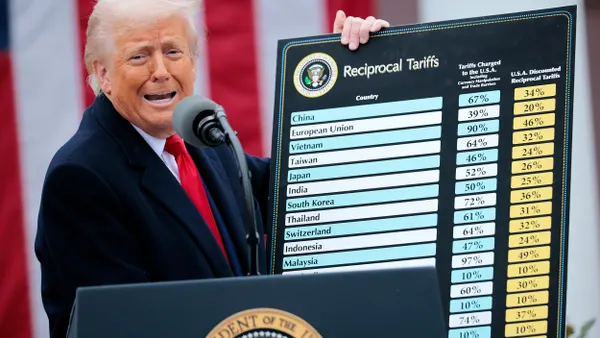Dive Brief:
- Retailer Walmart is focused on ensuring it can hit the right mix between pricing and value as higher-income consumers contribute a “larger percentage” of its market gains, executives said Tuesday during the company’s earnings call for Q3 of fiscal year 2025. Households making more than $100k made up 75% of the Bentonville, Arkansas-based company’s market share gains for the quarter, CEO Doug McMillon said.
- In categories such as grocery, “price obviously matters and so does quality,” CFO John Rainey said. As the company continues to attract higher-income consumers, it’s also seeing its share in pickup and delivery for categories such as gluten free products or organic produce rise, he said in response to analyst questions. That speaks to the company’s ability to provide “a great opening price point” as well as to sell high quality products, Rainey said.
- The retailer raised its full-year guidance following a strong quarter, where delivery and same-store sales rose. However, future headwinds could cause Walmart to hike some prices in the future — in the face of the potential tariffs proposed by President-elect Donald Trump, for example, there will “probably be cases where prices will go up for some consumers,” Rainey told CNBC in an interview following the company’s earnings.
Dive Insight:
Low prices have been a key pillar of Walmart’s strategy for decades, with the company slashing costs for 6,000 products during its most recent quarter — including approximately 3,000 grocery products, Rainey said Tuesday.
For the quarter ended Oct. 31, Walmart reported net sales for the U.S. grew 5% year-over-year to $114.9 billion. Total revenues reached $169.3 billion, a 5% increase from the prior year period, according to its earnings report.
Growth in Walmart’s e-commerce segment especially spiked, with global sales jumping by 27% YoY due to store-filled delivery growth of nearly 50%, according to the company. Its e-commerce losses also continued to narrow, though the segment hasn’t hit profitability yet — something that is a “long-term game” for Walmart, CFO Rainey said Tuesday in response to analyst questions.
Walmart is continuing to make investments in technologies such as automation to reduce costs as well as delivery speeds, but “if investments in delivery speed cause us to reach profitability a little later, that's fine too. We want to deliver faster,” Rainey said.
The company is “very confident that we’re going to make money in e-commerce. Whether that happens today, tomorrow or a week from now or a month from now, quarter from now, I don't really care,” he said.
Following its strong quarter, Walmart upped its guidance for the full year, now anticipating net sales of approximately $642.6 billion, representing a 4.8% to 5.1% increase, the company said. This compares to guidance for the previous quarter where Walmart expected net sales to rise between 3.75% to 4.75%.
The retailer also aims to rely more on automation, generative AI and other technologies to improve customer experiences, speed deliveries and cut costs.
Walmart has continued to automate its supply chain, leading to reduced cost for delivery orders, Rainey said. More than 50% of the company’s fulfillment center volume is now automated, a factor which “contributed to the third consecutive quarter of approximately 40% reduction in U.S. net delivery cost per order,” he said Tuesday.
In October, Walmart announced a suite of AI-powered services and tools designed to accelerate the age of “Adaptive Retail,” which included its large-language model, Wallaby—an LLM aimed at improving customer experiences, according to the release.
Walmart is already seeing “early tangible results” from the introduction of such tools, CEO McMillion said Tuesday.
“I'm a little hesitant to talk about AI because I know someone will hear this in the months and years to come and chuckle about how old school it sounds, given how fast things are changing,” McMillon said. “But it's important to convey that we're learning and applying generative AI, AI and machine learning to solve the practical opportunities right in front of us.”















